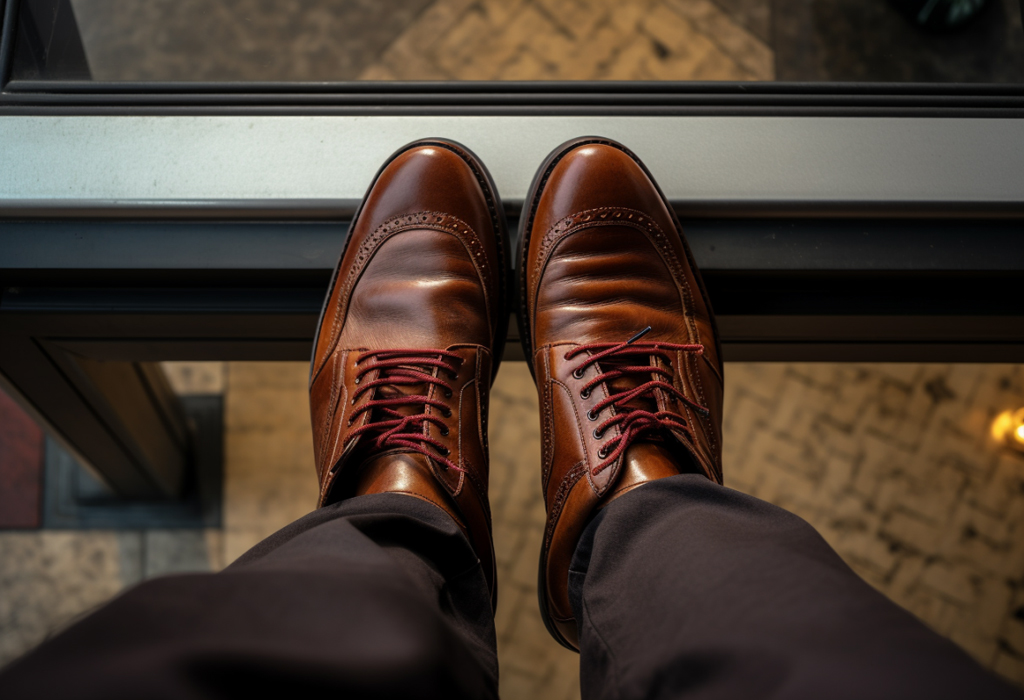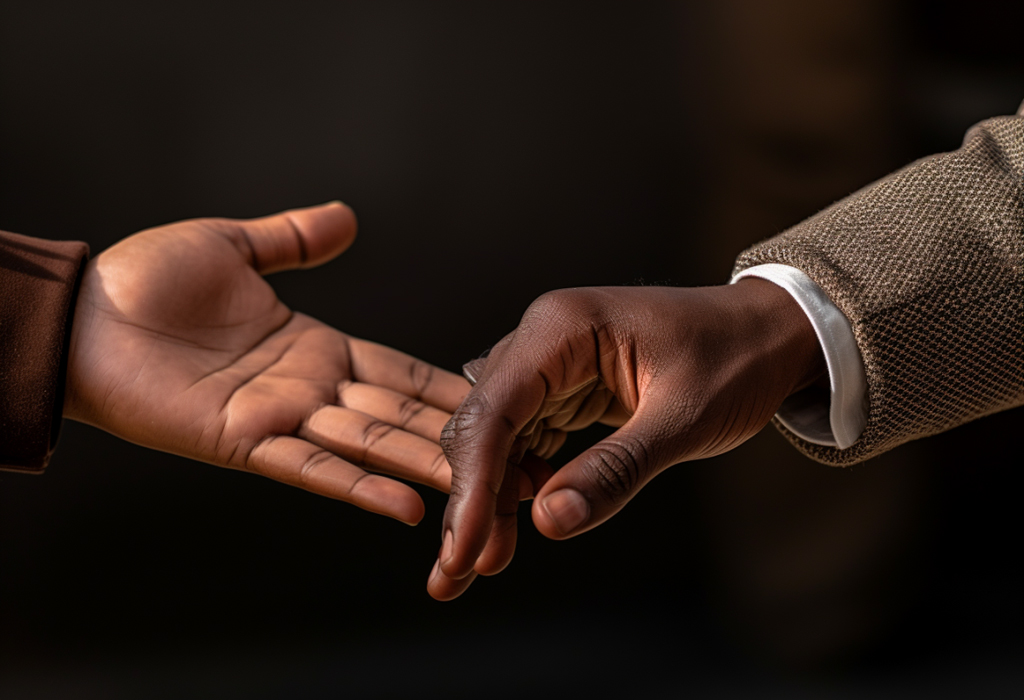[ad_1]
What is negative body language? Is it always obvious or quick to spot?
Not exactly. We are creatures of habit after all. And many of us can get used to sitting the wrong way or making the wrong gestures.
But don’t worry. The good news is these can be fixed.
First we’ve got to identify each thing that counts as negative body language. Then we can work towards solving them.
1. Bad Posture

This is one of the more overlooked forms of negative body language. You might think that bad posture only leads to physical problems. Wrong.
The reality is bad posture also negatively impacts your mood, stress levels, and self-esteem. In fact, drooped shoulders can cause you to look and feel tired and weaker than you actually are.
How To Fix: Good posture involves having your shoulders relaxed and not slumped. You also want your head, body, and thighs to be in a straight line. If you often need to sit down to accomplish something, it helps to get a chair designed to help you sit upright. Adjust your car seat properly so your head touches the headrest. Make it a habit to keep looking ahead of you since the body follows the eyes.
Good posture involves having your shoulders relaxed, with your head, body, and thighs in a straight line.
Wear clothes that fit you! Poorly fitting clothes (ex: if the sleeves aren’t large enough for your arms) encourage you to slouch in order to “shrink” into them. Overall, improving your posture does take a while and it may feel unnatural at first. But it’s totally worth the time and effort.
2. Poor Legs & Feet Position
Whenever you’re seated, your legs and feet can send across messages that you’re not even aware of. The distance between both your knees or legs can say something about your personality.

If your knees are together and your feet apart, you can come off as insecure of childish. By crossing your legs, you can appear defensive, distant or even close-minded. And then there is manspreading. Keeping your legs wide apart signals a certain degree of dominance. But it can also reveal arrogance and it’s often inappropriate in formal situations.
And even if your legs aren’t too close or far apart, your feet can be a liability. Foot movements are a big ‘tell’ that we often aren’t conscious of. The more your feet tap on the floor or go up and down, the more likely you are to show nerves and anxiety.
Sit with both legs close to each other in a neutral position.
How To Fix: Sit with both legs close to each other (not tightly together) in a neutral position. This allows you to come across as calm, attentive and open to conversation. Remember to keep your legs in front of you and not to the side. Like clasped hands, this can signal you’re not feeling confident or comfortable at the moment. And lastly, keep both feet still and flat on the floor.
3. Crossed Arms

The problem with crossed arms is – like when making an X sign to shield yourself in kids games – they make you seem like you’re being defensive. Whoever’s interacting with you might perceive you as unimpressed or uninterested with what they’re telling you. And ultimately, crossing your arms doesn’t make you look approachable.
How To Fix: Hold your arms back. The trick is keeping them parallel to the body. Not only does that show how open you are to conversations, but it signals power and confidence. Studies have even revealed that you’ll remember over 25% more when listening with uncrossed arms.
4. Poor Hands & Fingers Position

There are several things you can do with your hands and fingers that represent negative body language. First, there’s clasping your hands. It’s a common action for people when they’re feeling stressed, but it’s counterproductive when you’re doing business with others and you’re supposed to project self-assurance.
Next is keeping the hands behind your back or in your pockets. It might be a position most of us take subconsciously, but it does put you at risk of acting like you’re hiding something. It’s also not good either to rub your palms while sitting down, or to place the fingers of one hand over the other hand to form a “steeple.” These gestures can be associated with being deceitful or imposing.
How To Fix: The main objective is exposing the palms of your hands. Why? Doing so sends a neurological signal of honesty and positive engagement with others. People who don’t see your palms during conversations might feel defensive and suspicious of you.
5. Handshakes That Are Weak/Too Strong

I know. Handshakes aren’t the easiest thing to master. Unfortunately, a weak or overly strong handshake is one of the more extremes types of negative body language. Especially when first impressions are on the line.
Weak handshakes are considered weak because they involve sweaty hands or cold hands or hands that barely make contact with the other person’s palm. They can paint a picture of someone who lacks authority and confidence. Or they indicate someone who’s just cold in nature. Meanwhile, handshakes with too much force are considered too strong and make you come off as aggressive.
How To Fix: Give a few up and down shakes (no more than 3) and maintain eye contact while shaking somebody’s hand. You can add your left hand to better show a sense of care or sincerity but only do so if appropriate. People are two times more likely to remember if you shake hands with them well. They also end up being more open and friendly.
6. Too Little/Too Much Eye Contact

A lot to be said about eye contact. Too little of it spells bad news in many different ways: you’re acting unprofessional, you’re unprepared, you’re insecure or being insincere with others. It can seriously hurt you right off the bat at a party or during a date.
There’s a reason we’re taught as children to look people in the eye while talking or listening. It makes them feel trusting and comfortable with you. However, body language expert Carol Kinsey Goman also states that too much eye contact yields the opposite effect. It can make one seem rude, intimidating or hostile.
How To Fix: There is what’s called the “50/70 rule” (for those living in North America at least). You want to look somebody in the eye 50% of the time while speaking, and 70% while listening to them. The sweet spot for holding eye contact each time is 3-5 seconds. But remember that such eye contact rules depend on the country or cultural background.
7. Leaning Back

In conversations, remember the key is leaning forward – not back. If you lean forward, you confirm that you’re listening closely and you’re showing interest in what’s being said.
Leaning back gives the opposite impression of acting bored or onchalant. Nevertheless, bear in mind not to too much or you might seem needy or desperate to the other person.
8. Exaggerated Gestures

We know the saying less is more. And the “more” in this case can be classified as negative body language, especially since it detracts from the pluses about you.
This includes moving your arms wildly or frequently, biting your nails or touching the cuffs of your shirt. These point to a lack of professionalism and confidence on your end.
9. Not Gesturing Enough

Be careful also not to control yourself to the point of NOT making gestures. If you show near-zero movement to the other person, you’ll appear rigid and unnatural. It can seem like you’re consciously trying not to show emotion. And that tends to be a turn-off.
How To Fix: Gesturing as we talk is actually a good way to power-up our thinking. Brain studies reveal that a region called Broca’s area (which is vital for speech production) is active not only when we’re talking, but when we move our hands as well. So it helps during a presentation to throw in a hand gesture here and there. And if appropriate, try placing your hand on your heart if you want to say something sincere. That gesture is associated with showing integrity and honesty.
10. Fidgeting
Fidgeting is a sign of boredom. It’s a nuisance to both the listener and the talker. So whether it’s moving your fingers around or fidgeting with your hair, phone or any other object – it draws attention away from whatever is being said. And you end up appearing weak, uncomfortable or disruptive.

How To Fix: Hold your hands in your lap. Use them to gesticulate when you speak or try holding a pen and pad if they tend to move a little bit. Try NOT to hold your phone or use it during a conversation or meeting. And when you feel the urge to fidget, take a few deep breaths to help yourself relax.
11. Not Mirroring Others

Why is mirroring a good thing? Because it allows you to build a rapport with other easily. Mirroring things such as the other person’s posture, seating position, body angle (although it must be done in moderation!) helps you gain people’s trust. It allows for deeper and meaningful conversations. This is especially crucial in business when you’re meeting someone for the first time.
Guess what? It turns out men find mirroring harder than women, but women are more influenced by the act of mirroring. This causes women to find men who mimic their gestures and posture more attractive.
12. Not Smiling

Smile. It’s not natural for everybody to do it randomly or without a real reason. But smiling does have a natural, feel-good power. While some don’t pay close attention to how your limbs are positioned, the majority of people do react to what’s conveyed on your face.
A genuine smile comes on slowly. It causes a crinkling of the eyes and your face lights up, and then it fades away gradually. Nothing jerky or exaggerated. Master that smile. When you know the right moments to use it, it’ll put those around you at ease. It’ll help break the ice at parties. And besides, smiling makes you feel good yourself!
13. Looking Bored While Listening

It’s a simple problem with a simple solution. Remember to smile and nod when someone is speaking to you. Those are easy tactics to employ to let them know you’re actively listening to what they say. Also, make sure that your head and torso are facing the speaker. Don’t stare at your phone or watch or how others are reacting.
14. Barriers

Physical objects – even if that aren’t part of your body – can be detrimental to a meeting or collaborative session with others. You want to put aside anything that either blocks your view or forms a “barrier” between you and the rest of the team. That includes even a coffee cup. A senior executive was known to say he could evaluate his team’s confidence by how high they held their coffee cups. The higher the cup was held, the more insecure one felt.
15. Patting Your Leg (Or Legs)

As innocent as it looks, this is a clear self-comforting gesture that shows how uncomfortable you might be at the moment.
What’s one good example? Consider the time Britney Spears appeared on Dateline, claiming her marriage was fine a few months before she would file for divorce. She couldn’t stop patting her leg during the interview.
16. Touching Someone With Your Fingertips

There’s basically a fine line here. When the situation is appropriate, you can touch someone lightly in order to start building a bond (or to show romantic interest when you’re on a date). The thing is you should use your whole hand while touching. A mere touch with your fingertips is a hand gesture that can signal aversion or hesitation.
17. Invading One’s Personal Space

There’s no clear-cut rule when it comes to personal space. But you want the distance between you and the other person somewhere between 1.5 feet and 5 feet, in general. It is a wide range as we all have different “buffers” around ourselves that allow us to feel comfortable.
What’s most important is knowing that someone isn’t close with you – even if you work together – and respecting those boundaries. You can let your partner, family members or friends come physically closer and vice-versa, but it’s not the case with other people.
18. Pointing
Pointing is rude. Plain and simple. I’d even advise you not to point at yourself since it can either portray you as a bit arrogant, or it can seem like an exaggerated gesture that turns off the other person.
19. Baby Steps

You’re not a baby anymore. So why allow yourself to take small baby steps in the manner of shuffling or creeping?
The negative body language in these cases is walking like you’re timid, sluggish or unwell. You want to take big steps and firm strides instead. Trust me, they do wonders for your ability to look and become more confident.
20. Forgetting That These Rules Might Be Different In Other Places
I’m no expert in body language for all parts of the world. But who isn’t? We can’t just rely on our knowledge of what works and doesn’t work in our own setting. Rules and nuances in meaning vary. They depend on the country or its history, or even the way others have grown up in another side of your country. So please keep that in mind and always do your research whenever you travel.
What can I say, gents? Body language matters. It can influence whether we get to go farther or get left behind – in work, in our relationships or in life overall. Non-verbal communication is just as important, if not more important than saying the right things. So do watch out for these examples of negative body language. And master how to fix them.
Click Below To Watch The Video – Negative Body Language – Communication Mistakes & How To Fix Them
[ad_2]
Source link

Hi! I’m a dedicated health blogger sharing valuable insights, natural remedies, and the latest scientific breakthroughs to help readers lead healthier lives. With a holistic approach to wellness, I empower individuals with accessible and actionable content, debunking myths and offering practical tips for incorporating healthy habits.